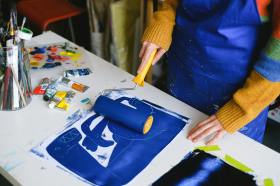-
Make your bed
As Charles Duhigg notes in his book, The Power of Habit, ‘Making your bed every morning is correlated with better productivity, a greater sense of well-being and stronger skills at sticking with a budget.’ Making your bed is what he calls a “keystone habit”, something that kick-starts a pattern of other good behaviour. And since it happens at the very beginning of the day, you’re apt to make better decisions for the remainder of the day thanks to your bed-making routine.
-
Smile
Studies have shown that smiling – even when you don’t feel like it – can make you feel happier. Study lead Dr Robert Zajonc found that the physiology of facial expression is a cause of emotion in its own right. And the same is true for frowning.
-
Don’t read the comments
If you have any sort of public profile and your confidence is shaky, for the love of God, try to avoid any negative comments about yourself. Get a trusted friend to screen the comments and let you know of anything particularly important, but for the sake of your self-worth, don’t read them yourself.
-
Affirmations
Affirmations are not just hokey, they work on the psychological truth that we are highly suggestible. Whatever your rational brain says, your subconscious will read and believe the Post-it on your desk or mirror. So tell yourself ‘I can do this’ or ‘I have great ideas’.
-
Acknowledge it
Squashing our feelings down doesn’t make them disappear; rather, it can have the opposite effect. Acknowledge the fact that you are feeling insecure or anxious, give yourself a minute or two to really feel that feeling, then let it go and move onto the next thing.

-
Picture Donald Duck
That negative voice in your head that tells you to give up? Imagine that voice sounds like Donald Duck or a Chipmunk, and you’ll find it harder to take it seriously.
-
Create momentum
When you are feeling overwhelmed, just choose the smallest first step and begin there. So if you are beginning to write a book, just open a Word document and start coming up with some themes. Give yourself a 50-word goal: you’ll probably exceed it, but beginning is the hardest part.
-
Move your body
You don’t need to dive into an exercise routine when you are feeling creatively blocked – just going for a walk or doing some simple stretches can be enough to get the blood flowing. But doing some sort of regular movement can be great for conquering self-doubt, as the psychological and emotional benefits of physical exercise helps to maintain your energy levels, your mood and your brainpower.
-
Stop seeking validation
Are you waiting for permission or validation for your work? Stop! Creative people can feel guilty that they may not have a ‘real’ job, that they aren’t making enough money or working enough hours. That doesn’t matter. Art is important and valid, and will endure long after a society has collapsed.
-
Find the source
If you regularly battle self-doubt (and who doesn’t?), try and find the root cause. Are you comparing yourself to your peers? Have you had some difficult feedback? Are you just burnt out? Looking for the underlying reason can be a helpful way to begin to make positive changes.
-
Consider the worst case scenario
Imagine what would actually happen if you didn’t get all your artworks painted before your exhibition opened, or you never wrote another word, or you made a big mistake during a performance. Put yourself in that moment, and picture what the reactions would be at the time, the next day, the next month and the next year. Would it matter?
-
Think like a friend
If a friend came to you riddled with self-doubt, would you tell them: ‘It’s because you suck at everything you do and you have no talent. If you just had a new studio/more time/more money then everything would be perfect.’ Your friend would be horrified, but that is how we regularly talk to ourselves. This double-standard can be overcome by stopping the negative voice in its tracks, and replacing it with the kinder, more compassionate words that you would tell a friend.
-
Meditation
You don’t have to be a cross-legged yogi to benefit from meditation. Even a few minutes of conscious breathing while sitting on the train can be beneficial. For beginners, there are a few guided meditation apps, which are a great starting point. Meditation promotes divergent thinking, a state of mind in which we’re able to generate new ideas.
-
Create a ‘great’ list
Make a list of all the things that you are great at. Excellent coffee maker! Good Instagrammer! Makes great art! Refer to the list when you are feeling particularly down or unmotivated.

-
Get dressed
For many people, sitting in your pyjamas or old ‘house’ clothes is not conducive to creating great work. Sure, some people can produce masterpieces in any conditions, but the act of getting dressed properly (even if it’s just changing from pyjamas to painting clothes) is like preparing you for battle: it gets you in the frame of mind for work.
-
Curate your influencers
Motivational speaker Jim Rohn famously said that we are the average of the five people we spend the most time with. The people around us can have a huge effect on our well-being and confidence. If there is someone in your life who you finding draining and damaging, it may be time to let them go.
-
Say F*** It
John C Parkin’s philosophy is based on one principle: say ‘F**k it!’ to your problems. The simple two-word “therapy” has grown in to a movement including retreats, books and videos. When you are feeling overwhelmed and anxious, try chanting ‘F**k it, f**k it, f**k it’ and see how you feel.
-
Be a poser
Social psychologist Amy Cuddy’s 2014 TED talk ‘Your body language shapes who you are’ is one of the most watched TED talks of all time. In the talk, Cuddy outlines her research into the ways that certain postures can boost testosterone, lower stress levels and increase feelings of power. Two simple poses, held for one minute each, can have a dramatic effect on your overall confidence. Try it!
-
Write morning pages
In her 1992 book The Artist’s Way, Julia Cameron recommends what she calls “morning pages”: three pages of long-form “stream of consciousness” writing, first thing in the morning. It serves as a brain dump to empty out all the clutter, and let the more creative thoughts float to the top.
-
A creative date
Also mentioned in The Artist’s Way is the idea of taking oneself on an “artist date”, a ‘once-weekly, festive, solo expedition to explore something that interests you,’ writes Cameron. Take yourself on a solo trip to see a new film, a play you would never normally see or just a wander through a new-to-you part of town.

-
Clench your left hand
Doctor Amantha Imber is a psychologist and the founder of an innovation consultancy. “When we clench our left hand into a fist it activates a region called the extension memory system. So when this is activated it promotes unique thinking. In studies, the people who were not squeezing or were using their right hand and not their left hand, didn’t have as many creative thoughts. So if you clench your left hand, you will have more creative thoughts just through that simple action,” Imber says.
-
Raise your eyebrows
‘When it comes to creativity, if we can broaden our exposure to a wide range of things, it improves creativity. An experiment was held where one group of people were told to raise their eyebrows before a problem solving task. The others were told to do the opposite; instead of widening their eyes, they were instructed to narrow their visual field. It was found that those that raised their eyebrows produced more creative ideas,’ says Imber.
-
Make decisions in the morning
‘If you’ve got a decision to make, wait until the morning. Research calls this area ‘decision fatigue’. What we know about how the brain works is that if you think of your brain as a battery, in the morning when you wake up, it’s fully charged. So we have a lot of mental energy to make good decisions. But, during the day, we eat away at our energy and it eventually runs on empty. So this means the more decisions you make during the day, the worse the quality becomes,’ according to Imber.
-
Write by hand
Carrie and Alton Barron, the authors of The Creativity Cure, advise us to skip the Word doc and pick up a pen instead. Sometimes the whole experience of writing by hand – the feel of the pen, the smell of a fresh notebook – is all it takes to get creative juices flowing.
-
Look at something blue or green
According to the principles of colour therapy, the colours blue and green can promote creativity. Researchers say that’s because we associate blue with the ocean, sky and openness in general, while green signals growth.

-
Sit outside a box
Though it may sound a little strange, in one study, people who sat outside a box (literally) were better at thinking creatively than people who sat in it. No cardboard container handy? Try sitting in the hallway outside a room.
-
Be psychologically distant
Have you ever noticed that giving advice to a friend is easier than solving your own problems? This is because you are “psychologically distant” from your friend’s problem, meaning that the issue is not occurring in the present and does not affect you. According to a study from Indiana University, increasing the psychological distance between you and a problem boosts your creativity. You may also gain new insights and clarity by thinking about a problem more abstractly.
-
Give yourself deadlines
According to a study by MIT Sloan School of Management, setting self-determined deadlines for completing a project improves task performance and decreases procrastination. Simply give yourself a set amount of time to finish a task, and impose on yourself incentives for meeting the deadline and consequences for failure.
-
Create a portfolio
Get together some of your best work and look through it when you are feeling low. When you are in a creative slump, remembering that you once made good work can lift you up and encourage you to keep going.
-
Think like a child
Picasso declared: “Every child is an artist. The problem is how to remain an artist once we grow up.” But a recent study suggests that it’s possible to regain the creativity we’ve lost to maturity. A few hundred subjects were assigned to two different groups. The first was given the following instructions: “You are seven years old, and school is cancelled. You have the entire day to yourself. What would you do? Where would you go? Who would you see?” The second group was given the same instructions, except the first sentence was deleted. After writing for 10 minutes, the subjects were then given tests of creativity, such as inventing new uses for a car tyre or a brick. The students who imagined themselves as children scored far higher on the creative tasks, with nearly twice as many ideas as the other group. Picasso would be proud.
-
Restrict yourself
Famously, Dr Seuss wrote Green Eggs and Ham after a bet that he couldn’t produce a story using fewer than 50 words. The research shows Seuss was on to something. Most people naturally take the path of “least resistance” and build off older or existing concepts when brainstorming, which can lead to less creative ideas. In order to put the brain in overdrive, you can mimic Dr Seuss and place restrictions on yourself while creating, which will prevent you from falling back on past successes. If you usually write 1000-word short stories, try to create a story in under 500 words. Only use a small handful of chords in your song or colours in your design. The limiting nature of the task can bring out your most creative side.
-
Start small
‘What we need to do is say, “What’s the smallest, tiniest thing that I can master and what’s the scariest thing I can do in front of the smallest number of people that can teach me how to dance with the fear?” Once we get good at that, we just realise that it’s not fatal. And it’s not intellectually realise – we’ve lived something that wasn’t fatal. And that idea is what’s so key – because then you can do it a little bit more,’ said Seth Godin in a Brainpicker podcast.
-
Slow down
If you’re pressuring yourself to get your creative work out there as quickly as possible, then you may be uncomfortably aware that it’s not as good as it could be. Perhaps you’ve had some disappointing feedback, or you simply feel that you’re not very proud of your work. The answer is to go slow: taking a bit more time means you’ll have the confidence that you’ve done a good job.
-
Take a class
If you’re feeling creatively blocked, try taking a class. Are you a sculptor? Take a life drawing class. A pianist? Try knitting. Learning something in a completely different medium can open up the creative part of your brain and get things flowing again.
-
Everyone feels like a fraud
‘I have written 11 books, but each time I think, “uh oh, they’re going to find out now. I’ve run a game on everybody, and they’re going to find me out”,’ said Maya Angelou. When even one of the greatest writers in the world feels like a fraud, then what hope is there for the rest of us? If you suffer from Imposter Syndrome, remind yourself that nobody belongs here more than you and deep down, nobody really knows what they are doing.
-
Stand up straight
You mum was right: the next time you find yourself slumping in your chair or slouching your shoulders, sit up straight! According to research, doing so can lead to more confidence in your own thoughts. Plus, sitting with good posture can keep both your self-esteem and mood lifted.

-
Crank up the bass
Cranking up the tunes can do great things for your mind and body. And now, recent research suggests that listening to music may lead to feeling more powerful. And pump the bass: listening to heavy-bass songs promotes more feelings of power than the low-bass songs.
-
Try the 30 circles test
This idea comes from designer Tim Brown’s TED talk Creativity and Play. How does it work? ‘Take a piece of paper and draw 30 circles on the paper. Now, in one minute, adapt as many circles as you can into objects. For example, one circle could become a sun. Another could become a globe. How many can you do in a minute?’ instructs Brown.
Most adults struggle to reach 30, he notes, mostly due to our tendency to self-edit. (In general kids, apparently, race through all 30 without a problem.) The test is a great reminder that premature criticism is a great way to kill your creativity.
-
Practice makes perfect
Even if you’re blessed with oodles of natural talent, the ability to succeed and feel confident doesn’t rely on that alone. In fact, experts suggest that practising for a task or responsibility is more important than simply relying on your gifts. Prepping for the task at-hand (whether it’s a going through a presentation, practising public speaking etc) will boost your confidence and improve the quality of your work. Bottom line: dress rehearsals aren’t just for drama troupes.
-
Play an instrument
Many artists can benefit from getting out of their own heads, and playing an instrument is a great way to make that happen. While it’s certainly an investment in time and energy, learning to play an instrument may lead to a confidence boost. One study found that learning to play the piano in particular could lead to greater self-esteem. Bonus: it’s also been shown to sharpen the mind.
-
Daydream
What was I saying? Oh, right. We tend to take a more creative approach to problems when our mind is wandering (less so when we’re hunched over a computer with a deadline looming). So don’t worry about zoning out for a few minutes.

-
Keep toys nearby
Many creative design companies encourage employees to keep toys on their desks – from LEGO to Play-Doh. Building something physically with your hands can be just the creative jolt you need.
-
Compare yourself to yourself
This will eliminate a lot of unnecessary pain in your life. Focus on yourself, not the other people around you, no matter if they are more or less successful. Compare yourself to yourself. Improve yourself and see how you grow and become a more successful, more confident and happier person.
-
Show your work
This may seem like a scary one to start off with … but it’s one of the best ways to get a reality check on your work. If you’ve got any sort of contact with professionals in your field, find someone (preferably someone known for their kindness rather than their brutal put-downs!) and ask them to take a look at a small piece of your work. Ask for their honest opinion. Is it at a publishable or produceable standard? Do they see any key strengths in the work – or any weaknesses that could be improved?
You’re unlikely to get feedback telling you that your work is pure brilliance. But you may be surprised to find it’s better than you think. And hopefully you’ll get some suggestions for areas that need a little more development: this helps build your confidence by giving you clear and specific ways to grow.
-
Failure and success
Before she authored the blockbuster book Eat, Pray, Love, Elizabeth Gilbert was an “unpublished young diner waitress”, devastated by rejection letters. In a talk, she reflected on the strange and unlikely psychological connection between how we experience great failure and how we experience great success.
-
Use the ‘What If?’ technique
What if I switch the colours? What if I use a darker background? What if I use a different typeface? Exploring possibilities by letting your mind wander opens new opportunities for more creative ideas.
-
Spend time with nature.
A change in the environment helps a lot in keeping the creativity flowing. Spending time alone under a tree or watching the ocean waves will recharge your mind and get back to work with more creative and fresher ideas.
-
Unplug
Shut down your computer for a while. Take a walk and try to see the awesome things outside your studio that you are missing every single day. Unwind. Get away for a day or two. Having a break or a short vacation can recharge your creative self and get you back to work the next day overflowing with creative awesomeness!
-
Doodle
Although we may have been reprimanded in school to ‘stop doodling and pay attention’, it’s time to bring back the doodle. Doodling, contrary to popular opinion, does not demonstrate a lack of focus. In fact, doodling can help you stay present and engaged during an activity in which you may otherwise find your mind drifting.
Suni Brown, author of The Doodle Revolution, notes that some of the greatest thinkers – from Henry Ford to Steve Jobs – used doodling to jump-start creativity. Doodling can enhance recall and activate unique neurological pathways, leading to new insights and cognitive breakthroughs.
-
Think bravely
Legendary designer David Kelley designed a fantastical MRI machine that led to a 70% reduction in sedation rates for children undergoing the procedure. His TED talk offers ways to build the confidence to create and think bravely.






